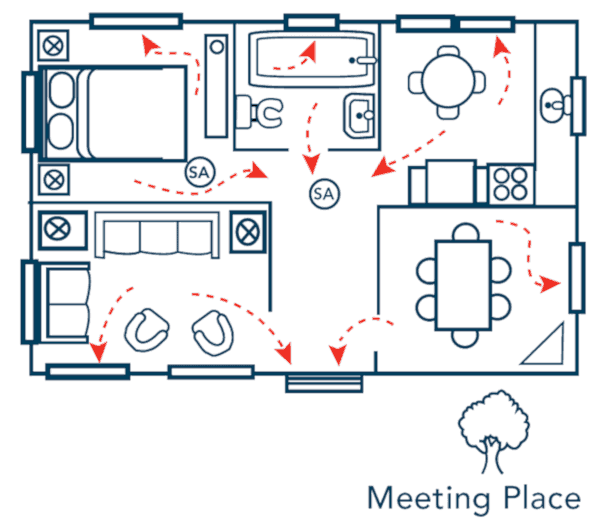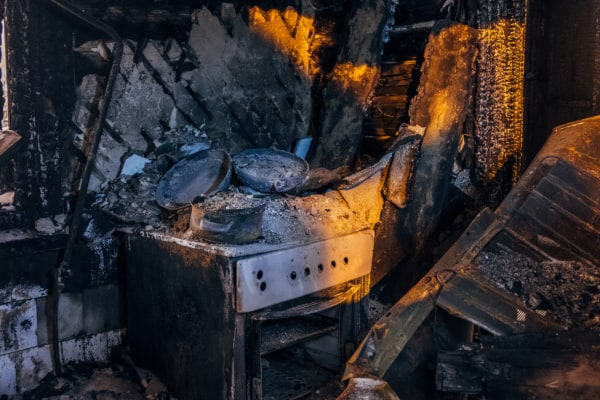Fire Prevention Week takes aim at kitchen fires, the source of most fire-related deaths at home
For nearly a century, the National Fire Protection Association (NFPA), has served as the official sponsor of Fire Prevention Week. First proclaimed by President Calvin Coolidge in 1925, this week-long observance commemorates the Great Chicago Fire, a blaze that claimed the lives of 250 people and left 100,000 homeless.
Among the sweeping changes that have followed in the wake of America’s deadliest fires is a commitment to modernizing fire safety. And for all the advances made over the years, one of the top fire hazards in today’s homes has remained as common today as it was decades ago: kitchen fires.
Kitchen fires remain the number-one source of fire and related injuries in the United States. More than 160,000 took place in 2016—and, surprisingly, this number has risen over the past three decades. The persistence of kitchen fires has made it a topic of discussion in several Fire Prevention Weeks, including in 2013, when the NFPA and other safety organizations made it their top priority.
In this article, we provide 13 tips for preventing kitchen fires. With safe practices and the right fire prevention equipment, homeowners and renters can keep their families safe—and place the dangers inspiring Fire Prevention Week in the rearview mirror.
QRFS invites consumers searching for home fire protection equipment to peruse our catalog of fire extinguishers, residential fire sprinklers, and CPVC pipe fittings for home fire sprinkler systems.
#13: Make a home fire escape plan
Proactive homeowners can take plenty of steps to prioritize fire safety. But one of the easiest, and most affordable, solutions is making a plan—and sharing it with the rest of the household. Planning is central to fire safety—so much so, that NFPA made it the central theme of 2019’s fire protection week.
Start by performing a “risk survey” to identify possible hazards. Draw a floor plan of the home, showing all doors and windows, along with two escape routes from each room. Remember: fire spreads quickly. Teach children how to escape on their own, to gather at a safe meeting place, and to stay out of the home after they exit.

#12: Catch kitchen fires early with smoke alarms
It’s hard to stress just how big of a difference working smoke alarms can make. In 2013, NFPA partnered with Dominos Pizza to deliver pizzas on fire engines and check home smoke alarms for Fire Prevention Week. Although we’ve put kitchen fires in the spotlight, it’s important not to place smoke alarms too close to cooking equipment, where ceiling-bound particles from pots and pans may trigger false alarms. Ideally, smoke alarms should be installed:
- 10 feet away from any cooking appliance
- No more than 12 inches away from the ceiling, but not within four inches of a peaked ceiling’s apex
- Inside and outside of each sleeping area
- On every level of the home
- Over the top of stairways leading to a basement
- Away from windows, doors, ducts, and other sources of drafts
Create a plan, such as marking your calendars in advance or setting an alert on your mobile phone or computer, to test your smoke alarm batteries once a month.
#11: This Fire Prevention Week, practice (and teach) safe cooking
Some safety tips are extraordinarily easy to follow. For starters, stay in the kitchen while stovetops remain active or ovens broil. Use a timer while cooking, and check on food at regular intervals. Critically, don’t place anything flammable near stovetops. If children have learned to cook, pass these tips along. If they haven’t, maintain a “kid-free zone” of three feet around stovetops.
Kitchen fires involving deep, hot grease can’t be effectively stopped with most fire extinguishers. Don’t try: the pressurized contents of an extinguisher may spread the fire. If the fire is small enough to fight, deprive the flames of oxygen, either by closing the oven door or placing a lid over a burning pan. If neither of these options seems safe, escape and call 911.
#10: Monitor children and pets
Teach younger children not to play with stoves, pans or appliances, and stay in the room when cooking if you have small children. Keep very young children in a safe area like a playpen in another room. Children under 5 are more likely to be hurt by touching hot equipment (or by contact with hot liquids) than the fire itself. In short, the kitchen just isn’t a safe place for most toddlers.
#9: Clean heat-generating appliances and practice appliance safety
Crumbs are to a toaster what sticks are to a fireplace: kindling. Removing them from the tray periodically can prevent some smaller kitchen fires. Regular cleaning should be the norm for any heat-generating appliance in a kitchen. The grease burned to the outside of consumers’ waffle makers, or the charred food stuck to stove elements, can ignite. The video below shows just how devastating heat-generating appliances can be:
Two other neglected forms of appliance safety can also make a difference. First, don’t use outdated heat-generating appliances. Old toasters can get stuck or malfunction, generating heat for far longer than they should. Second, don’t run more than one heat-generating appliance from a single outlet. Waffle-makers, toaster ovens, and similar devices can cause damage to outlets that may lead to fires. In a similar vein, appliances that generate great deals of heat—from large toaster ovens to washers—should plug directly into outlets using no extension cords. Fire Prevention Week has given organizations like the Electrical Safety Foundation International (ESFI) and Seimens a public forum to advocate for fire-resistant outlets and more careful use of extension cords.
#8: Keep liquid shortening, butter, or other flammable liquids protected from burners
Erie, Pennsylvania’s Erie Insurance notes that combustible foods can quickly become fire hazards. Some, like cooking oils or greases, are obvious fire hazards. But alcohol-based sauces, like Marsala and sherry, can explode if placed too close to a hot stovetop. Butter can quickly catch fire in an extremely hot pan, as can shortening. And some oils, while hazardous, may be less flammable than others. Some oils smoke or boil earlier than others, with olive oil having a smoke point 40 degrees lower than peanut oil.
#7: Keep fire extinguishers fully charged and accessible
Most fire extinguishers aren’t designed for grease fires. But they can do an excellent job of fighting kitchen fires consuming countertops, cabinets, electrical appliances, and wall outlets. Unfortunately, many families don’t have a working fire extinguisher or don’t have it readily available. While fire extinguishers don’t have much aesthetic appeal, placing them out of sight can prove deadly to visiting family members, guests, renters, and customers for home vacation rentals.
In our guide to home fire extinguisher selection and placement, we explained that these devices should be placed:
- Away from direct sources of heat, which may damage them
- Somewhere obvious and accessible (not in the back of a sink or closet)
- Near an exit, so users can escape if the fire grows too large
It’s also important to recharge or replace extinguishers as needed. While fire extinguishers used in a workplace or commercial building have periodic inspection and maintenance requirements, an out-of-sight extinguisher may also remain fully out of mind. They may slowly discharge, rendering them inoperable.
#6: Know what type of fire suppression to use for each type of fire
Different classes of fire require different fire extinguishers or extinguishing methods. To sum up the most common distinctions:
- Carbon dioxide (C02) extinguishers can stop fires in some flammable liquids and energized electrical equipment. Don’t use them for kitchen grease fires, fires in your trash can, or other solid burning materials.
- Dry chemical ABC extinguishers stop fires in ordinary solids, flammable liquids, and electrical equipment. Again, these extinguishers won’t work with a deep fryer or deep grease.
- Wet chemical (Class K) extinguishers can stop kitchen grease fires. But this isn’t something most homeowners are likely to have. Instead, they’re typically kept in commercial kitchens.
Fires on stoves or ovens that involve grease can often be stopped by placing a lid on a pan or closing the oven door. A baking sheet may also do the trick. In a pinch, baking soda or salt may also work. Don’t use water or attempt to move the flaming material, which may spread the fire.
Knowing how to properly use a fire extinguisher has been a focus of Fire Prevention Week in years past, including in the city of Kirksville, Missouri:
#5: Many kitchen fires can be stopped by keeping flammable items away from hot appliances
This tip really could save your life: keep loose clothing, curtains, dishcloths, towels, or boxes away from the stove area when cooking. Clothing is the first thing to burn in a kitchen fire only 1% of the time—but it contributed to 15% of recorded home cooking fire deaths. Keeping combustible materials too close to heat sources is the third-leading contributor to home cooking fires and the second-leading contributor to associated deaths. The NFPA’s 2018 report entitled “Home Cooking Fires” notes that the elderly are at particularly serious risk:
Five of every six (83%) of [clothing ignition] victims were 65 or older. While it is important for all who cook to wear snug or short sleeves, this is especially critical for older adults.
#4: Don’t apply spray grease inside the oven
This year, at least eight people filed lawsuits against a leading manufacturer of cooking spray. The cans exploded while cooking, users allege, causing severe burns and even blindness. As the video below shows, it’s not the first time spray grease has made headlines as a potential fire hazard:
When spraying pans with nonstick coatings, remember to always remove the pan from the stove or oven. These products contain flammable ingredients such as oils and propellants that can burn (or explode) when exposed to open flames or hot heating elements. Always store spray grease away from sources of heat in accordance with the manufacturer’s instructions.
#3: Keep pan handles turned toward the center of the stove or countertop backs
Why? As fire departments around the country have noted, orienting cooking equipment in this way makes it less likely that a pot or pan will get bumped or knocked over. It also reduces children’s odds of scalding themselves.
#2: Safely check gas appliances for leaks
…by mixing a solution of liquid soap and water and brushing it onto all connections (points where pipes and fittings meet). If there is a leak, the escaping gas will cause bubbles to form, as shown in the video below:
Some potential sources of kitchen fires that might be checked with this method include:
- Barbecue grills
- Pipes behind stovetops or ovens
- Appliances located in spaces adjacent to the kitchen, including water heaters or gas dryers
If you smell a mild gas leak, turn off any sources of ignition, exit the house, and contact the utility company. For more severe cases, call 911.
The #1 tip for preventing damage and injuries from kitchen fires is…
Installing home fire sprinklers—the only proactive fire protection system that reacts automatically to heat, not smoke, and doesn’t require you to be in the room to suppress the fire. These systems can use either home plumbing or standalone piping to deliver low-flow protection throughout the home. They require minimal maintenance and can use lightweight, inexpensive piping options that significantly reduce costs.
QRFS’s wide-ranging catalog of residential fire sprinkler equipment includes:
- CPVC pipe fittings
- Residential fire sprinklers
- Fire sprinkler cover plates
- Fire sprinkler escutcheons
- Residential risers
Stay safe this Fire Prevention Week with products and know-how from QRFS.
Questions? Call us at +1 (888) 361-6662 or email support@qrfs.com.
This blog was originally posted at blog.qrfs.com on October 8, 2013 and updated September 26, 2019. If this article helped you, check us out at Facebook.com/QuickResponseFireSupply or on Twitter @QuickResponseFS.


